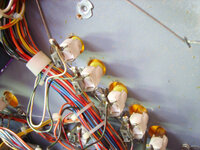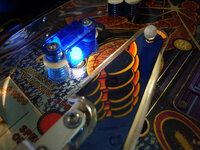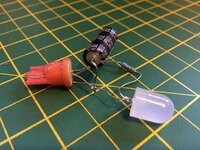Indeed I will! Or have! Admittedly I've just stuffed them in without any modifications, e.g., resistors, etc., so the fact that anything works at all on a machine this old is a miracle. I will in due course do proper tests... this was just half an hour during my lunch break.Never seen a vector with LEDs before. Give it a go!
Respect to Dave Mainwaring aka @alchy at http://www.pinball-led.co.uk/ for getting my order to me in just 1 day!
All the bulbs on Vector are #555 wedges. From left to right fitted in the 2x, 3x and 5x inserts are Concave, Superbright and Premium 2 in green:

Vector: LED Testing by staticboy, on Flickr
From left to right fitted in the 1, 2 and 3 THOUSANDS inserts are Concave, Superbright and Premium 2 in blue:

Vector: LED Testing by staticboy, on Flickr
From left to right fitted in the 5, 10 and 15 THOUSANDS inserts are Concave, Superbright and Premium 2 in yellow:

Vector: LED Testing by staticboy, on Flickr
Hard to take photos of flashing lights! But somehow I got the Concave and Superbright in green (2x and 3x) and the Superbright blue in the 2 THOUSAND:

Vector: LED Testing by staticboy, on Flickr
Warm White Frosted this time in the left slingshot and inlane/outlane guide:

Vector: LED Testing by staticboy, on Flickr
Under the front plastic is a Cool White Frosted and behind under the curved plastic a Blue Frosted. I'm not sure about either the warm or cool white, but do like the blue Frosted under that curved plastic. Vector has quite a lack of under-plastic GI so it would be great to add a load using LEDs without adding any extra strain on the power supply. In fact, as 1 incandescent is the same as at least a dozen LEDs the overall current draw will be lower even if I add 20-30 extra playfield GI lamps!

Vector: LED Testing by staticboy, on Flickr
And a couple of videos. Especially impressed with the Superbright in green on the 3x insert. Based on these very preliminary tests I prefer the Superbright over the Concave (not bright enough) and Premium 2.
Last edited:





